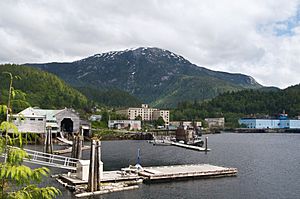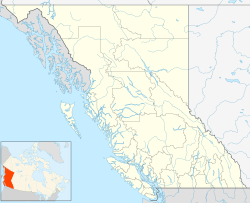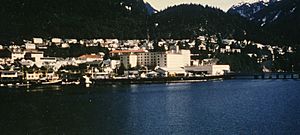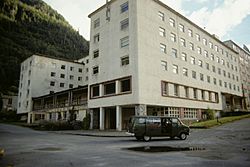Ocean Falls facts for kids
Quick facts for kids
Ocean Falls
|
|
|---|---|
|
Community
|
|

Ocean Falls waterfront in June 2009
|
|
| Country | Canada |
| Province | British Columbia |
| Regional District | Central Coast |
| Population | |
| • Total | About 50 |
| Demonym(s) | Rain People |
| Time zone | UTC-8 (Pacific Standard (PST)) |
| • Summer (DST) | UTC-7 (PDT) |
| Postal code span |
V0T 1P0
|
| Area code(s) | 250 |
Ocean Falls is a small community located on the central coast of British Columbia, Canada. It used to be a big town owned by a company called Crown Zellerbach. Today, only about 50 people live there full-time, but more visitors come during certain seasons. You can only reach Ocean Falls by boat or seaplane.
Contents
Where is Ocean Falls?
Ocean Falls is famous for getting a lot of rain. It rains about 4,390 millimeters (173 inches) every year! Because of this, the people who live there are sometimes called the "Rain People."
The community is built around a beautiful waterfall. This waterfall carries water from Link Lake directly into Cousins Inlet. This natural feature provides a lot of energy that could be used for power.
A Look Back: Ocean Falls' History
Early Inhabitants
For over 9,000 years, the coastal area around Ocean Falls was home to Indigenous peoples. These included the Heiltsuk and Nuxalk speaking communities.
The Mill Town Begins
In 1903, a company called Bella Coola Pulp and Paper Company explored the area. They were very impressed by how much hydro power could be made from the waterfall.
- In 1906, the company bought land and started clearing it to build a town.
- Three years later, a sawmill, a hospital, and a school were built.
- In 1912, a dam was put in place, and the pulp mill started working.
For many years, the Ocean Falls pulp and paper mill was the largest in British Columbia. It made different types of paper and pulp. Most of the electricity for the mill and the town came from four hydro turbines.
Population Changes
- In 1912, about 250 people lived in Ocean Falls.
- By 1950, the population grew to 3,500 people.
- However, by 1970, it dropped to 1,500.
- By 1990, only about 70 people remained, mostly loggers.
Why the Mill Closed
Over time, the mill became less profitable. It was expensive to run a town in such a remote location. Also, the cost of workers increased. The mill was very old and needed a lot of money to be updated.
By the early 1970s, the mill was not working well and was losing money. The owner, Crown Zellerbach, decided to close it in March 1973. The government of British Columbia bought the mill and town to keep it open. They managed to keep it running until 1980. After that, the Ocean Falls mill closed, like many other old, remote mills in the area.
Today's Ocean Falls
Much of the old town has been taken down. Many of the buildings that are left are falling apart. However, Ocean Falls still has a small community. Many former residents also stay connected.
Town Disasters
Ocean Falls has faced several tough times:
- In 1950, a big apartment fire killed eight people.
- In 1965, a mudslide killed seven people.
- On December 21, 1969, the Charleson school burned down. Luckily, no one was seriously hurt.
Even though the school burned, classes quickly started again. Teachers got desks from Bella Bella. Students had classes in different places around town, like the community center and even a pub for older students. A new school, with one of the biggest indoor gyms in British Columbia, opened in 1971.
Life and Work in Ocean Falls
A Company Town
At its busiest, Ocean Falls was home to about 3,900 people. It had a school for all grades, its own hospital, one of the province's largest hotels, and a swimming pool. Many swimming champions even trained there!
Ocean Falls was a "company town." This means the company that owned the mill also ran and took care of the entire town. They managed housing and provided services like water, electricity, and heat at a low cost. This made living in Ocean Falls very affordable. Some people could buy their own homes in a nearby area called Martin Valley.
Town Layout and Transport
The town had many apartments, duplexes, and single-family homes. Most buildings were on the steep slope of Caro Marion mountain. The main store and other small shops were along the harbor. Important buildings like the courthouse, Legion Hall, Royal Canadian Mounted Police building, and Post Office were also near the harbor.
Many roads leading up the hills were made of strong timber. These roads could handle large vehicles like trucks and fire engines. There were very few cars in town, usually just one taxi. Most cars belonged to people living in Martin Valley.
Harbor and Travel
The harbor was well-protected from wind. It had plenty of space for local and visiting boats. The harbor was kept deep enough for large ships to dock at the mill's warehouses.
- Grumman Goose and Mallard planes, which can land on water, flew passengers daily from Vancouver.
- Freighters also brought supplies from Vancouver.
Only one large cruise ship, the SS Rotterdam, ever visited Ocean Falls on May 18, 1997. The town had only 50 residents, but they successfully hosted 1,100 visitors! People hoped more cruise ships would visit, but it didn't happen. On October 6, 2019, another cruise ship, the MV Seabourn Sojourn, sailed near Ocean Falls, but no one went ashore.
There is a sign on a road that says, "July 13, 1929, Give to the world the best you have and the best will come back to you - Willy Buttner."
Modern Economy
Today, Ocean Falls is home to a Bitcoin mining operation. This is because there's a lot of unused electricity available. After the pulp mill closed, only a third of the dam's power was used. This was enough for Ocean Falls and nearby communities like Shearwater and Bella Bella. The dam is not connected to the main power grid, so the extra power can only be used locally.
Famous People from Ocean Falls
Ocean Falls has been home to several notable individuals:
- John Horgan: He later became the Premier of British Columbia. He worked at the Ocean Falls pulp mill when he was a university student.
- Ralph Hutton: A swimmer who won a silver medal at the 1968 Summer Olympics.
- Ian MacKenzie: A swimmer who represented Canada at the 1972 Summer Olympics. He won a gold medal at the 1974 Commonwealth Games.
- Jerrold Marsden: A famous professor at Caltech, born here in 1942.
- Dick Pound: A swimmer who won a gold medal at the 1962 British Empire and Commonwealth Games. He later became president of the World Anti-Doping Agency.
- Olive Sturgess: An actress who appeared in television and films, born in Ocean Falls in 1933.
Climate
| Climate data for Ocean Falls | |||||||||||||
|---|---|---|---|---|---|---|---|---|---|---|---|---|---|
| Month | Jan | Feb | Mar | Apr | May | Jun | Jul | Aug | Sep | Oct | Nov | Dec | Year |
| Record high °C (°F) | 15.0 (59.0) |
16.1 (61.0) |
20.6 (69.1) |
25.0 (77.0) |
32.2 (90.0) |
35.6 (96.1) |
35.6 (96.1) |
39.4 (102.9) |
32.2 (90.0) |
22.8 (73.0) |
17.2 (63.0) |
14.0 (57.2) |
39.4 (102.9) |
| Mean daily maximum °C (°F) | 3.2 (37.8) |
5.2 (41.4) |
7.0 (44.6) |
9.9 (49.8) |
14.0 (57.2) |
17.2 (63.0) |
19.5 (67.1) |
19.8 (67.6) |
16.8 (62.2) |
11.7 (53.1) |
6.4 (43.5) |
3.8 (38.8) |
11.2 (52.2) |
| Daily mean °C (°F) | 1.1 (34.0) |
2.8 (37.0) |
4.1 (39.4) |
6.3 (43.3) |
9.8 (49.6) |
13.2 (55.8) |
15.6 (60.1) |
16.2 (61.2) |
13.7 (56.7) |
9.2 (48.6) |
4.3 (39.7) |
1.8 (35.2) |
8.2 (46.7) |
| Mean daily minimum °C (°F) | −1.1 (30.0) |
0.4 (32.7) |
1.0 (33.8) |
2.7 (36.9) |
5.6 (42.1) |
9.2 (48.6) |
11.6 (52.9) |
12.4 (54.3) |
10.5 (50.9) |
6.8 (44.2) |
2.3 (36.1) |
−0.3 (31.5) |
5.1 (41.2) |
| Record low °C (°F) | −18.3 (−0.9) |
−15.0 (5.0) |
−16.7 (1.9) |
−5.0 (23.0) |
−7.2 (19.0) |
1.1 (34.0) |
3.9 (39.0) |
2.2 (36.0) |
1.1 (34.0) |
−17.8 (0.0) |
−20.0 (−4.0) |
−17.8 (0.0) |
−20.0 (−4.0) |
| Average precipitation mm (inches) | 512.4 (20.17) |
409.9 (16.14) |
323.6 (12.74) |
318.2 (12.53) |
238.1 (9.37) |
195.8 (7.71) |
155.5 (6.12) |
197.9 (7.79) |
366.0 (14.41) |
587.8 (23.14) |
492.4 (19.39) |
503.2 (19.81) |
4,300.8 (169.32) |
| Average snowfall cm (inches) | 63.7 (25.1) |
30.5 (12.0) |
11.1 (4.4) |
2.1 (0.8) |
0.0 (0.0) |
0.0 (0.0) |
0.0 (0.0) |
0.0 (0.0) |
0.0 (0.0) |
1.7 (0.7) |
11.9 (4.7) |
34.0 (13.4) |
155 (61.1) |
| Average precipitation days | 20.0 | 18.0 | 20.0 | 19.0 | 18.0 | 16.0 | 13.0 | 14.0 | 17.0 | 22.0 | 21.0 | 20.0 | 218 |
| Source: Environment and Climate Change Canada | |||||||||||||
See also
 In Spanish: Ocean Falls para niños
In Spanish: Ocean Falls para niños




